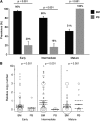Molecular evidence for the localization of Plasmodium falciparum immature gametocytes in bone marrow
- PMID: 24335496
- PMCID: PMC4067503
- DOI: 10.1182/blood-2013-08-520767
Molecular evidence for the localization of Plasmodium falciparum immature gametocytes in bone marrow
Abstract
Plasmodium falciparum immature gametocytes are not observed in peripheral blood. However, gametocyte stages in organs such as bone marrow have never been assessed by molecular techniques, which are more sensitive than optical microscopy. We quantified P falciparum sexual stages in bone marrow (n = 174) and peripheral blood (n = 70) of Mozambican anemic children by quantitative polymerase chain reaction targeting transcripts specific for early (PF14_0748; PHISTa), intermediate (PF13_0247; Pfs48/45), and mature (PF10_0303; Pfs25) gametocytes. Among children positive for the P falciparum housekeeping gene (PF08_0085; ubiquitin-conjugating enzyme gene) in bone marrow (n = 136) and peripheral blood (n = 25), prevalence of immature gametocytes was higher in bone marrow than peripheral blood (early: 95% vs 20%, P < .001; intermediate: 80% vs 16%; P < .001), as were transcript levels (P < .001 for both stages). In contrast, mature gametocytes were more prevalent (100% vs 51%, P < .001) and abundant (P < .001) in peripheral blood than in the bone marrow. Severe anemia (3.57, 95% confidence interval 1.49-8.53) and dyserythropoiesis (6.21, 95% confidence interval 2.24-17.25) were independently associated with a higher prevalence of mature gametocytes in bone marrow. Our results highlight the high prevalence and abundance of early sexual stages in bone marrow, as well as the relationship between hematological disturbances and gametocyte development in this tissue.
Figures


Comment in
-
Uncovering the hideout of malaria sexual parasites.Blood. 2014 Feb 13;123(7):954-5. doi: 10.1182/blood-2013-12-545418. Blood. 2014. PMID: 24526777 No abstract available.
References
-
- Miller LH, Baruch DI, Marsh K, Doumbo OK. The pathogenic basis of malaria. Nature. 2002;415(6872):673–679. - PubMed
-
- Hawking F, Wilson ME, Gammage K. Evidence for cyclic development and short-lived maturity in the gametocytes of Plasmodium falciparum. Trans R Soc Trop Med Hyg. 1971;65(5):549–559. - PubMed
-
- Sinden RE. Malaria, sexual development and transmission: retrospect and prospect. Parasitology. 2009;136(12):1427–1434. - PubMed
-
- Smalley ME, Abdalla S, Brown J. The distribution of Plasmodium falciparum in the peripheral blood and bone marrow of Gambian children. Trans R Soc Trop Med Hyg. 1981;75(1):103–105. - PubMed
Publication types
MeSH terms
Substances
Grants and funding
LinkOut - more resources
Full Text Sources
Other Literature Sources

